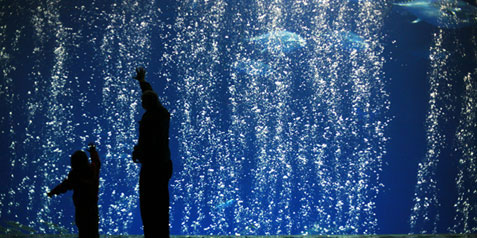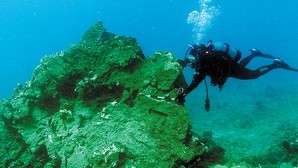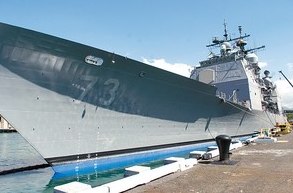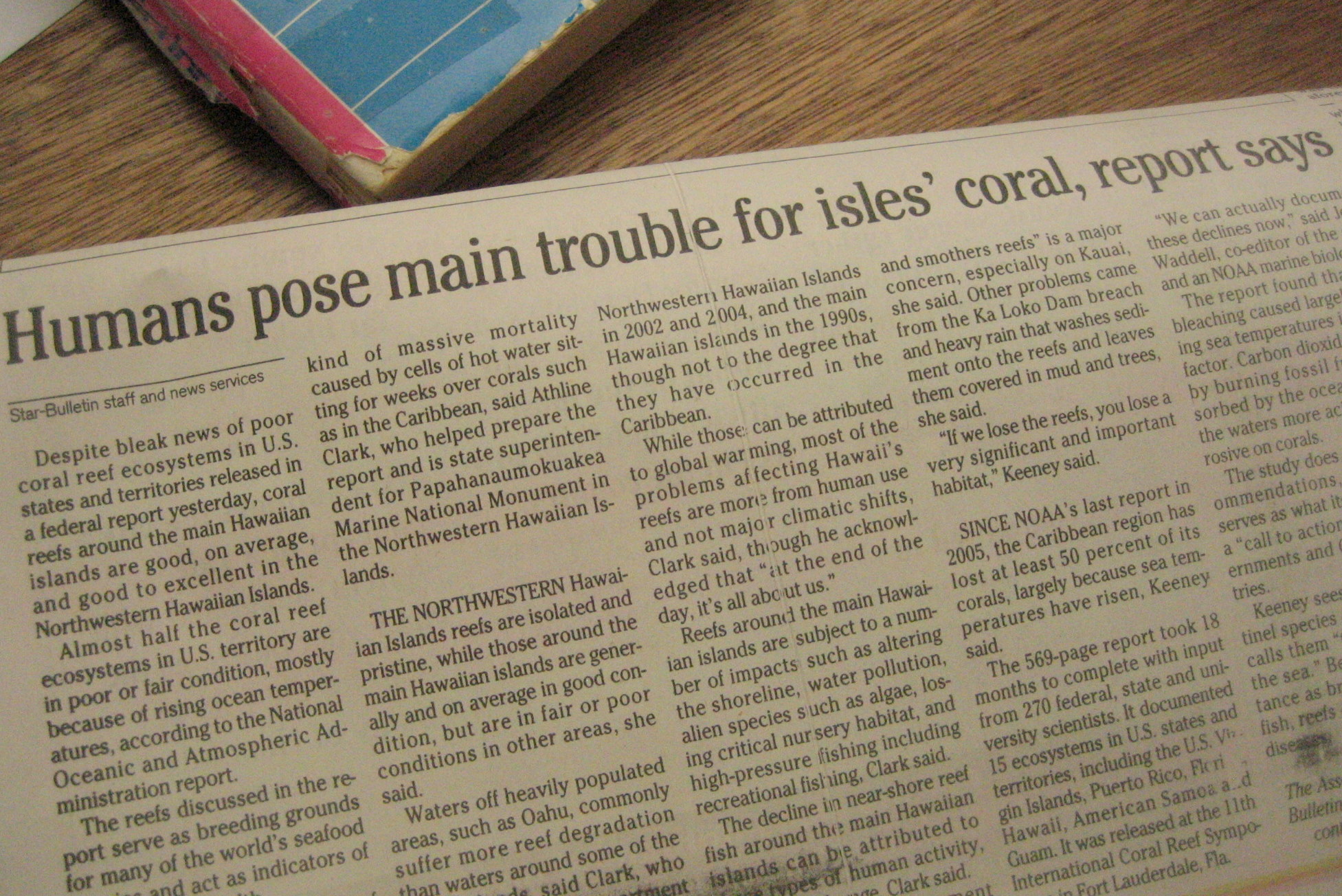Blog
News, updates, finds, stories, and tidbits from staff and community members at KAHEA. Got something to share? Email us at: kahea-alliance@hawaii.rr.com.
- no limit on military activities affecting Monument resources (not even a discussion of what it would take to abide by the proclamation and “minimize and mitigate” half-pound pieces of fiery shrapnel hitting Nihoa).
- no ban on bioprospecting, which is the taking of public trust resources for exploitation and profit by corporations, academic institutions, and private individuals.
- no limit on the number of people that can access and/or take from this “no take” reserve.
- no assessment of the cumulative risks and impacts of past and anticipated human activity in the Monument.
- no public advisory council, which has been key in forcing transparent & accountable decisionmaking.
A Sea Change--film on ocean acidification
From Alana:
On Thursday night, a film entitled A Sea Change, was shown at the Bishop Museum. It addressed the much ignored by-product of climate change, ocean acidification. Ocean acidification is, arguably, the most dire consequence of adding ridiculous amounts of carbon dioxide to the air.
For years, the ocean has been absorbing extra CO2 from the air, a total of 118 billion metric tons of it. Adding 22 billion pounds of CO2 to the ocean each day is severely changing the chemistry of the water. But what is wrong with the pH of the ocean lowering by .1, or .01, or even .001? It may not seem like much to us, but any change affects what all life depends on most: the creatures at the bottom of the ocean food chain, namely pteropods. Pteropods are moth-like, transparent creatures, that seem to fly in the deep ocean. They are the food for a myriad of creatures, which in turn are the food source for hundreds of other creatures, that humans then feed on. Increased amounts of CO2, though, are causing the pteropods’ calciferous shells to disintegrate. This threatens the entire food chain.
Scientists have underestimated the magnitude and haste of climate change. They assert that we are past the point where we can stop the extinctions that will come with the disappearance of pteropods and coral. This situation is so extreme that within a few centuries humans could be all but extinct as well. As one scientist simply exclaims, “we’re screwed”.
The thing that disgusts me most about all of this, though, is that we could have solved it by now. It would only cost TWO PERCENT of our GDP to solve the energy crisis. It can be argued that 2% of GDP is a lot of money, but I think it might be a good asking price for ensuring the continuation of our survival as a species, and the survival of the animals we depend on. To put this in perspective, enough photovoltaic cells could have been built to power the entire United States with only $420 billion–HALF of the Iraq war budget.
A big hurdle that the public has to face is simply realizing how much we rely on the ocean, and that it is in fact possible for us to change something that big. Most people accept the fact that the ice is melting, but continually deny that life is endangered because of human activity. One woman in the film says,
“We are a very visual species. What is below water is invisible to us. What we can’t see, we pollute… because it doesn’t exist to us.”
So what can we do about this? The main thing to do is just analyze your lifestyle and make sure that what you do doesn’t add to this serious problem. Venture capitalists have the choice of going down the alley of exploitation as easily as the alley of sustainability. The government owes it to everyone to do something about this. This type of problem will threaten national security, the world food supply, etc, so when is anyone going to do something about this in terms of strong legislation– or creating an actual plan of action?? Depending on your age, you may not see the effects, but it is real. It is not going away. I know that there will not only be a sea change in my lifetime, but a world of change.
Draft Science Plan Public Hearing: Grandfathering-in Permitted Activities
From: Andrea
Last night at the public hearing on the Draft Science Plan for Papahanaumokuakea Marine National Monument, held at the monument office in Hawaii Kai, a troubling consequence of the lack of environmental review was elucidated.
One of the Science Plan authors stated that research activities that have already been permitted are assumed to have gone through a “rigorous” review by management. The problem?
Actually, there could be quite a few from this muddy statement. For one, this statement suggests that research activities that have already been permitted will not be scrutinized- nor, certainly, environmentally assessed- in the future. It sounds like grandfathering-in existing and previous permits, meaning some activities that have been permitted in the past will be continuously assumed to pass muster, despite never actually being environmentally reviewed.
Clearly, grandfathering-in research activities so that they never undergo environmental review creates informational ravines that make cumulative impact analysis impossible. Cumulative impacts, the incremental impacts of an action when added to other past, present, and reasonably foreseeable future action, must be assessed. The managers need to understand the big picture, especially when making seemingly small decisions like permitting.
Secondly, what is this “rigorous” review that the manager mentioned? There has been no environmental assessment on any permits nor the entire permitting system nor the Science Plan, so it clearly was not environmental review. If this rigorous review were undertaken via the prioritization system of the Science Plan, that, too, is problematic.
As I have blogged before, the Science Plan has two tragic flaws: (1) the prioritization scheme that doesn’t actually prioritize permit activities (To prioritize permit activities, it asks, pros and…pros?, leading to 97% of potential research activities to be ranked as “critical” or “high” in importance.) and (2) the lack of environmental review.
But, the environmental assessment did not come with the Science Plan. The managers argue that this is the draft plan, so environmental assessment is not appropriate now. However, they also proclaim the plan to be an evolving document- not problematic necessarily. The evolving nature of the plan is problematic, however, for lack of environmental review because, if it is meant to evolve, when would the managers consider environmental review appropriate? There could always be an argument that it is not truly finalized yet if it’s an “evolving” document.
On the other side, if the monument managers, in fact, conduct an environmental assessment for the Final Science Plan, which is the next step after last night’s public hearing, the decision on permitting prioritization will have been made. And, environmental assessment is legally required to take place prior to decision-making. The whole point of environmental review is for decision-makers to be informed of environmental impacts before they make final decisions.
So, either the Science Plan truly is an evolving document, in which case an environmental review is likely to be put off forever. Or, the Science Plan will be finalized in the next step, the Final Science Plan, which frustrates the point of environmental review taking place before decisions are made.
Confusing? Yes. But it need not be.
KAHEA urges the monument managers to take the straightforward approach by conducting environmental review of the Science Plan, which guides the entire permitting process, prior to finalization of the plan. KAHEA also urges environmental review of all permits- no grandfathering-in. Each proposed permit should be looked at with a fresh eye, through the lens of cumulative impacts, which inherently change over time.
Let’s hope that public comments are indeed incorporated into the Final Science Plan, whenever that may be. Otherwise, the one-sided prioritization system will continue to rank most activities high, leading to excessive access and impact in a fragile, irreplaceable ecosystem.
What can you do? Speak up!
Last public hearing on the Science Plan is in Hilo tomorrow:
Hawai‘i, July 23th, 6-8 p.m.
Mokupapapa Discovery Center,
308 Kamehameha Ave, Suite 203, Hilo, HI, 96720.
All written public comments must be received by the monument managers by or before August 10.
• U.S. Mail:
Papahanaumokuakea Marine National Monument, Attn: Science Plan Comments, 6600 Kalaniana‘ole Hwy, Suite 300, Honolulu HI, 96825
• E-mail: nwhicomments@noaa.gov.
To read the plan:
http://papahanaumokuakea.gov/research/plans/draft_natressciplan.pdf
(It takes a few minutes to download, but once you’re there, skip to page 10 for the prioritization chart.)
KAHEA SUES STATE TO PROTECT NWHI
KAHEA Suit Asks Court to Enforce Law On Permits
Complaint Follows Whistleblower Suit By State Worker
“This is not the wild west; there are laws here.”
From Stewart:
The Northwestern Hawaiian Islands are known around the globe as one of the world’s last intact, fully functional marine ecosystems. They are home to highly endangered Hawaiian monk seals and the birthplace of more than ninety percent of threatened green sea turtles. Thousands of people participated in the establishment of the islands as the Papahanaumokuakea Marine National Monument, which led state and federal regulators to commit to a “do no harm” policy for all human activities allowed in the monument. The monument is intended to be one of the most protected places on earth, with access strictly limited by the do-no-harm policy and applicable state and federal laws.
Despite these protections, the state of Hawaii Department of Land and Natural Resources and the Division of Aquatic Resources have ignored their legal obligations when permitting activities in the reserve. The agencies have brushed aside KAHEA’s repeated objections to the agency’s practices. And when a lawyer working as a policy specialist to the Division of Aquatic Resources dared point out that the division was failing to follow the law the law, the division responded by firing the lawyer.
KAHEA has decided enough is enough.
“This is a place of enormous cultural significance of the Hawaiian people and is intended to be one of the world’s most protected places,” said Marti Townsend, program director and staff attorney for KAHEA. “It is unfortunate that the agencies have forced us to take legal action simply to get the agencies to follow the law, but they left us no choice.”
“This is not the wild west; there are laws here. Laws that are meant to protect our natural resources and the best interests of Hawaii’s people,” said Kumu Hula Vicky Holt-Takamine, KAHEA’s Board President. “DLNR must follow these laws.”
Holding the Navy Accountable on Two Fronts
From Marti:
The Navy has been on the hot seat lately for the damage it has caused in Hawaii nei. In central and western Oahu, the Environmental Protection Agency and the state got a commitment from the Navy to clean up any remaining contamination at two Superfund sites – one in Lualualei near the naval munitions storage area and the other in Wahiawa. While preliminary investigations have indicated that no immediate threats currently exist at the sites, soil contaminants at the sites include PCBs, volatile organics, semi-volatile organics and metals. PCBs can cause cancer in animals and adversely affect the nervous, immune, and endocrine systems in humans.
“Our agreement with the Navy and the state finalizes the process that the Navy will follow to complete the investigation and clean up of any remaining chemical contamination at both sites.” said Keith Takata, director for the EPA Pacific Southwest Region’s Superfund Division.
The agreement with the Navy is open to public comment. Get your say in now by visiting: www.epa.gov/region09/NavalComputer
Check out the full article at The Hawaii Independent: http://www.thehawaiiindependent.com/hawaii/oahu/2009/04/02/epa-us-navy-agrees-to-clean-wahiawa-lualualei-superfund-sites/
 And, on the South shore of Oahu, controversy is brewing as the state attempts to hold the Navy financially responsible for the carnage of coral from the USS Port Royal grounding in February 2009. Ten acres of ancient coral was destroyed! Chunks as large as cars are still bouncing around on the ocean floor causing further damage.
And, on the South shore of Oahu, controversy is brewing as the state attempts to hold the Navy financially responsible for the carnage of coral from the USS Port Royal grounding in February 2009. Ten acres of ancient coral was destroyed! Chunks as large as cars are still bouncing around on the ocean floor causing further damage.
“There is a critical need for the U.S. Navy to mitigate the damage which has occurred, which continues to occur, and which will get worse with the upcoming south summer swell,” said Laura H. Thielen, chairwoman of the DLNR, in the letter.
“We urge the U.S. Navy to commit appropriate resources to rescue disturbed or destroyed coral, remove or stabilize rubble, and protect loose live coral that has resulted from this incident.”
Here, here!! Systems that ensure the “polluter pays” are a completely reasonable (and actually quite capitalist) approach to addressing damage to our environment. The Navy’s negligence destroyed a significant part of our ocean environment. They should be required to pay for the injury they have caused and do all they can to prevent further damage.
What the Navy does in this situation will be a key indication of what the public can expect from their activities affecting the Papahanaumokuakaea Marine National Monument in the Northwestern Hawaiian Islands (you will recall the Navy plans to intercept chemical-laden missiles over Nihoa – the only home of at least four endangered species and one of the most significant cultural and archeological sites in the archipelago).
Check out the full article here: http://www.honoluluadvertiser.com/article/20090402/NEWS11/904020369/1001
Understatement of the Month
From the Honolulu Advertiser coverage of the grounding and sewage release by the U.S. Navy’s 567-foot Port Royal:
The omission was one more bit of embarrassment heaped onto the 3 1/2-day spectacle of a 9,600-ton warship capable of shooting down ballistic missiles in space sitting helplessly aground in 17 to 22 feet of water just off Honolulu International Airport’s reef runway.
We’d like to officially submit “one more bit of embarrassment” as the understatement of the month.
Full article at: http://www.honoluluadvertiser.com/apps/pbcs.dll/article?AID=/20090211/NEWS08/902110398

Are they hoping nobody would notice?
From Marti:
Late in the day on December 23rd, the final version of the Monument management plan was quietly published on the Papahānaumokuākea website. No press release. No email to the list serv. Just a quick post on the eve of the Eve of Christmas, which just happened to get picked up in a google alert days later.
Given all the eco-mojo the Bush Administration has tried to squish out of this “blue asterisk,” you would expect a mighty deal be made of finally finishing the management plan two years later. The fact that the release was so secretive has gotta make you wonder what’s actually in it.
On their website, James Connaugton, chairman of the White House Council on Environmental Quality is quoted as saying:
“When President Bush first designated the Papahānaumokuākea Marine National Monument in June 2006, his goal was to move beyond just thinking about conservation to carefully managing this important area.”
Yikes! What does the federal government mean exactly when it says “move beyond” conservation?
Well, from what we see in the plan it means:
Over 50% of the proposed 355 million-dollar budget is for government operations and research, while a mere 12% goes to reducing existing threats, like clean-up of marine debris and legacy military contamination. The plan also fails to allocate sufficient resources for Native Hawaiian involvement in Monument decision-making, and leaves decision-making to a closed-door Monument Management Board.
The plan essentially abandons the “precautionary principle,” which was a hallmark of the State’s visionary pre-monument protections that required biological, cultural and historic resource integrity be favored when the impacts of any proposed activity were uncertain.
So while the revised vision, mission, and goals now commit to conservation as the purpose of the Monument, you can see that the actions to implement this plan remain largely unimproved over the weak draft released earlier this Spring.
When the draft version of this plan was released, the National Wildlife Federation, the Center for Biological Diversity and more than a dozen other organizations–representing well over 5 million people–joined KAHEA in strongly criticizing the management plan. Despite two years of advocacy, and thousands of public letters and comments calling for a stronger, more protective plan, it is apparent that our united call for a true pu‘uhonua didn’t fit with the federal government’s vision for the future of “conservation” in the Northwestern Hawaiian Islands.
So, here’s our take – a quote for the papers – on the federal government’s attempt to “move beyond” conservation:
“This is conservation on paper, but not in practice. They have reshuffled the goals to say ‘full conservation’ but their proposed actions speak louder than their words. They are exempting increased military exercises proposed for this extremely delicate ocean habitat from management. They are proposing increased tourism, new construction, and extractive research without adequate public oversight and Native Hawaiian consultation,” said Marti Townsend, Program Director of KAHEA: The Hawaiian-Environmental Alliance.
To learn more about this issue, including a detailed review of the draft plan, visit our website at: www.kahea.org
but we knew that already
Star-Bulletin headline from yesterday: “Humans pose main trouble for isles’ coral, report says.” So says the report-back from the 11th International Coral Reef Symposium.
The good news is that on average Hawaiian reefs are doing better than those in other places under United States jurisdiction, despite pressures from human impacts. According to the report, the Northwestern Hawaiian Islands–an area whose remoteness has protected it from many types of human impacts–are still considered relatively pristine.
Full story here: http://starbulletin.com/2008/07/08/news/story03.html






